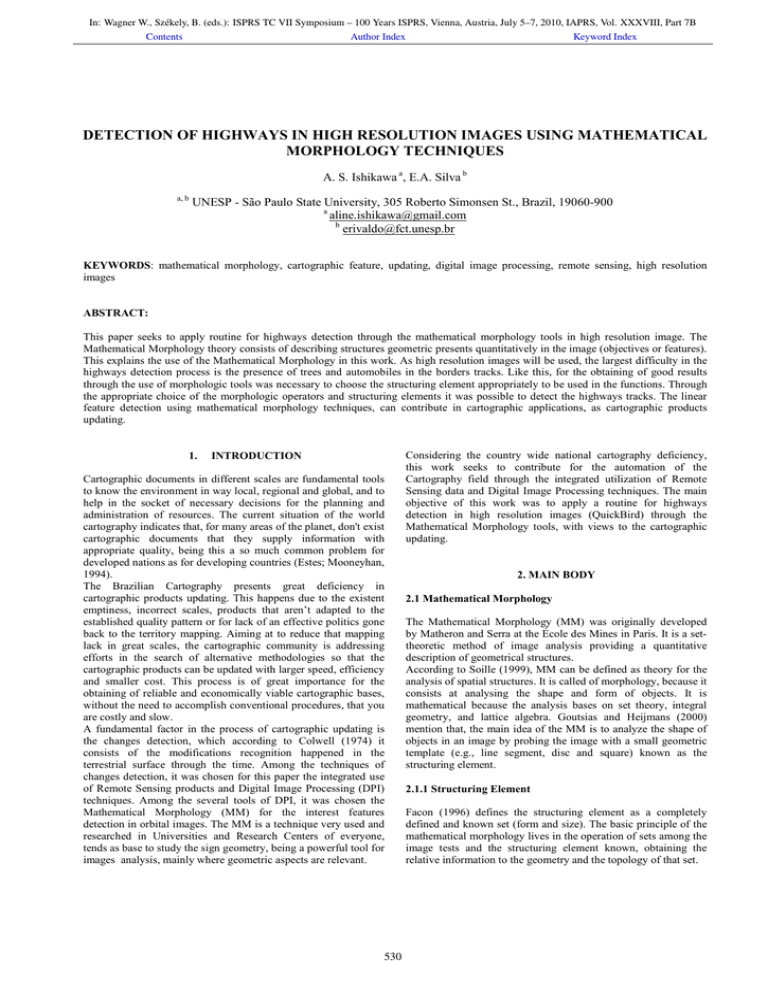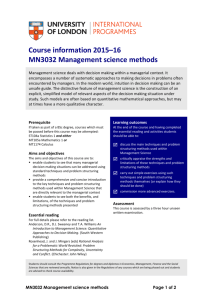DETECTION OF HIGHWAYS IN HIGH RESOLUTION IMAGES USING MATHEMATICAL MORPHOLOGY TECHNIQUES
advertisement

In: Wagner W., Székely, B. (eds.): ISPRS TC VII Symposium – 100 Years ISPRS, Vienna, Austria, July 5–7, 2010, IAPRS, Vol. XXXVIII, Part 7B
Contents
Author Index
Keyword Index
DETECTION OF HIGHWAYS IN HIGH RESOLUTION IMAGES USING MATHEMATICAL
MORPHOLOGY TECHNIQUES
A. S. Ishikawa a, E.A. Silva b
a, b
UNESP - São Paulo State University, 305 Roberto Simonsen St., Brazil, 19060-900
a
aline.ishikawa@gmail.com
b
erivaldo@fct.unesp.br
KEYWORDS: mathematical morphology, cartographic feature, updating, digital image processing, remote sensing, high resolution
images
ABSTRACT:
This paper seeks to apply routine for highways detection through the mathematical morphology tools in high resolution image. The
Mathematical Morphology theory consists of describing structures geometric presents quantitatively in the image (objectives or features).
This explains the use of the Mathematical Morphology in this work. As high resolution images will be used, the largest difficulty in the
highways detection process is the presence of trees and automobiles in the borders tracks. Like this, for the obtaining of good results
through the use of morphologic tools was necessary to choose the structuring element appropriately to be used in the functions. Through
the appropriate choice of the morphologic operators and structuring elements it was possible to detect the highways tracks. The linear
feature detection using mathematical morphology techniques, can contribute in cartographic applications, as cartographic products
updating.
1.
INTRODUCTION
Cartographic documents in different scales are fundamental tools
to know the environment in way local, regional and global, and to
help in the socket of necessary decisions for the planning and
administration of resources. The current situation of the world
cartography indicates that, for many areas of the planet, don't exist
cartographic documents that they supply information with
appropriate quality, being this a so much common problem for
developed nations as for developing countries (Estes; Mooneyhan,
1994).
The Brazilian Cartography presents great deficiency in
cartographic products updating. This happens due to the existent
emptiness, incorrect scales, products that aren’t adapted to the
established quality pattern or for lack of an effective politics gone
back to the territory mapping. Aiming at to reduce that mapping
lack in great scales, the cartographic community is addressing
efforts in the search of alternative methodologies so that the
cartographic products can be updated with larger speed, efficiency
and smaller cost. This process is of great importance for the
obtaining of reliable and economically viable cartographic bases,
without the need to accomplish conventional procedures, that you
are costly and slow.
A fundamental factor in the process of cartographic updating is
the changes detection, which according to Colwell (1974) it
consists of the modifications recognition happened in the
terrestrial surface through the time. Among the techniques of
changes detection, it was chosen for this paper the integrated use
of Remote Sensing products and Digital Image Processing (DPI)
techniques. Among the several tools of DPI, it was chosen the
Mathematical Morphology (MM) for the interest features
detection in orbital images. The MM is a technique very used and
researched in Universities and Research Centers of everyone,
tends as base to study the sign geometry, being a powerful tool for
images analysis, mainly where geometric aspects are relevant.
530
Considering the country wide national cartography deficiency,
this work seeks to contribute for the automation of the
Cartography field through the integrated utilization of Remote
Sensing data and Digital Image Processing techniques. The main
objective of this work was to apply a routine for highways
detection in high resolution images (QuickBird) through the
Mathematical Morphology tools, with views to the cartographic
updating.
2. MAIN BODY
2.1 Mathematical Morphology
The Mathematical Morphology (MM) was originally developed
by Matheron and Serra at the École des Mines in Paris. It is a settheoretic method of image analysis providing a quantitative
description of geometrical structures.
According to Soille (1999), MM can be defined as theory for the
analysis of spatial structures. It is called of morphology, because it
consists at analysing the shape and form of objects. It is
mathematical because the analysis bases on set theory, integral
geometry, and lattice algebra. Goutsias and Heijmans (2000)
mention that, the main idea of the MM is to analyze the shape of
objects in an image by probing the image with a small geometric
template (e.g., line segment, disc and square) known as the
structuring element.
2.1.1 Structuring Element
Facon (1996) defines the structuring element as a completely
defined and known set (form and size). The basic principle of the
mathematical morphology lives in the operation of sets among the
image tests and the structuring element known, obtaining the
relative information to the geometry and the topology of that set.
In: Wagner W., Székely, B. (eds.): ISPRS TC VII Symposium – 100 Years ISPRS, Vienna, Austria, July 5–7, 2010, IAPRS, Vol. XXXVIII, Part 7B
Contents
Author Index
For the obtaining of good results through the use of morphologic
tools is necessary to choose the structuring element appropriately
to be used in the functions. The element estruturante is the key for
the success of the operations, since it is chosen in an appropriate
way.
The choice of the element estruturante depends on the geometric
form object to be extracted in the image. For instance, linear
structuring elements are appropriate for the linear objects
extraction. It can also be considered several rotations of the
structuring element to extract the wanted forms from the objects
contained in the image. For instance, it is wanted to extract the
highways, the ideal would be to use a structuring element with
mask in form of line segment, however this element should be
rotated in several directions to answer the multiple orientations of
the highways. The size of the structuring element depends on the
characteristics that you want to extract in the image. Structuring
elements larger preserve larger characteristics while smaller
elements preserve smaller details in the image. Some examples of
structuring elements are shown in the Figure 1.
Keyword Index
b) Dilation: According to Soille (1999), the dilation of a set X
by a structuring element B is denoted by δ B (X ) and is defined
as the locus of points x such that B hits X when its origin
coincides with x:
δ B ( X ) = {x | B x ∩ X ≠ ∅}
(2)
For this definition, when the structuring element is verifying
the image, the neighborhood of the central point should have a
intersection with the relevant points of the image, capturing
more pixels. The application of this operator produces the
following effects: increases the objects in the image, fills out
small holes and connects close objects.
Erosion and dilation can be used in a variety of ways, in
parallel and series, to give other transformations including
thickening, thinning, pruning and many others.
c) Thinning: According to Soille (1999), the thinning of a set X
by a composite structuring element B is denoted by X Ο B and
defined as the set difference between X and the hit-or-miss
transform of X by B (HMTB(X):
(a)
(b)
XΟB = X \ HMTB ( X )
(c)
(3)
Figure 1. Structuring elements: (a) cross, (b) square and (c) line.
The type and nature of detected information depend of the
structuring element and studied image choice. The shape
and size of the structuring element must be adapted to the
geometric properties of the image objects to be processed.
The Mathematical Morphology presents as principle two basic
operations: Erosion and Dilation, from which all other
morphological operations are derived.
a) Erosion: According to Soille (1999), the erosion of a set X by
a structuring element B is denoted by ε B ( X ) and is defined as
the locus of points, x, such that B is included in X when its
origin is placed at x:
ε B ( X ) = {x | B x ⊆ X }
The hit-or-miss transformation of a set X by a composite
structuring element B=(B1, B2), is the set of points, x, such
that when the origin of B coincides with x, B1 fits X and B2
fits Xc .
HMTB ( X ) = ε B1 ( X ) ∩ ε B 2 ( X c )
(4)
d) Pruning: According to Soille (1999), the pruning
transformation is implemented through the detection of final
points and their removal up to the idempotency, in other
words:
PRUNE(X) = (X AFIs E)( ∞)
(5)
(1)
This definition indicates that the structuring element B slides
on the image and it compares the neighborhood of each pixel
with the neighborhood of the central point (that most of the
time will correspond to the physical center of the structuring
element) preserving the pixels where the neighborhoods
coincide. In general, the erosion presents the following effects
in their results: decrease of particles, elimination of the
inferior size grains than of the structuring element, increase of
the holes and it allows the separation of close grains.
531
Where E is related to the structuring element used to detect
final points and ∞ indicates that the sequential thinning is
iterated up to stability.
When the pruning is taken into stability, the only parts of the
skeleton not suppressed are the closed arcs or “ties” of the
skeleton.
2.2. Data Used
The test image chosen corresponds is a panchromatic image of the
high resolution satellite QuickBird, with spatial resolution of 61
cm. This contains as main feature a part of the Raposo Tavares
highway, located in the area of Presidente Prudente city (SP),
Brazil. The Figure 2 presents the original image.
In: Wagner W., Székely, B. (eds.): ISPRS TC VII Symposium – 100 Years ISPRS, Vienna, Austria, July 5–7, 2010, IAPRS, Vol. XXXVIII, Part 7B
Contents
Author Index
Keyword Index
original plan. Being the tracks without the presence of the "holes"
left by the trees, the next step was to accomplish its detection. For
this, the tracks were thinning and afterwards they went by the
pruning process, where the resulting segments of the thinning
stage were eliminated. Finally, with the intention of obtaining the
best result to be represented in the Cartography, a stage of
Morphologic Powder-processing was accomplished, which
consisted in dilatation the highway tracks seeking to obtain them
with its original thickness. For proof ends, the image containing
the highway detected was put upon on its original image,
verifying if there was some position displacement of the feature
detected.
Figure 2. Original Image.
2.3 Method
2.4. Presentation and Analysis Results
This paper consisted of using morphologic operators with the
objective of to detect highways in high resolution images. For
this, the Mathematical Morphology toolbox developed by SDC
Information Systems, coupled to the software Matlab 7.0 was
used in this experiment.
Initially, with base in the type of present structure in the image,
the morphologic operators and structuring elements more
appropriate were selected to process the image with intention of to
detect highways in other words, to detect elongated image
structures. The flowchart of the Figure 3 illustrates the stages
accomplished for the highways detection.
Initially, a stage of Morphologic Pre-processing was
accomplished with the objective of increasing contrast of the
highway tracks, contributing for the features detection process to
be successfully performed. For this, the first operator used was the
opening for reconstruction. This operator accomplishes the
reconstruction of an image starting from the eroded original image
that works as markers. The structuring element used was the
mmsebox (square mask). In the sequence, with the intention of
enhancing the features tracks, the addition operator was applied
with the value 120 by the whole scene. The result obtained is
illustrated in Figure 4.
Morphologic Pré-Processing
Conversion of the gray images in binary
Reconstruction of the tracks of the highways
(Suppression of the holes left by the trees)
Highways detection
Figure 4. .Image with the enhanced tracks.
Morphologic Post-Processing
Obtaining of results
Figure 3. Flowchart of the developed routine.
Firstly, the developed routine consisted in accomplishing a stage
of Morphologic Pre-processing where the brightness and contrast
values were altered, enhancing the interest features. This stage is
of great importance, because it allows the elimination of many
noises that aren’t part of the interest feature, making possible the
detection process. The next step was to convert the gray image in
binary. In the sequence, due to the presence of trees in the borders
tracks, these were rebuilt with the intention of obtaining its
532
The next step was to convert the gray image in a binary image.
The image was binarizated with a threshold 90, transforming all
of the pixels that have digital number below this threshold for the
value "0" (black) and the ones that were above in "1" (white). The
choice of this threshold was made in agreement with tests
accomplished through of the image histogram analysis. In the
sequence, seeking to eliminate the noises that aren’t part of the
interest feature, the erosion operator was applied on the image
through structuring element mmseline (mask line) with the
intention of disconnecting the noises close to the highway tracks.
The disconnected noises were eliminated through the operator
opening, which removed components with inferior size to 500
pixels. The obtained result is display in Figure 5.
In: Wagner W., Székely, B. (eds.): ISPRS TC VII Symposium – 100 Years ISPRS, Vienna, Austria, July 5–7, 2010, IAPRS, Vol. XXXVIII, Part 7B
Contents
Author Index
Keyword Index
Figure 7. Result of the pruning process.
Figure 5. Elimination of the noises around the feature.
By analyzing the result showed in Figure 4 it can be noticed that
the highway present continuity loss. This happened due to the
presence of trees in the borders tracks in the scene acquisition
instant, hiding information regarding the plan of the same ones.
This way, it was necessary to accomplish a reconstruction of the
tracks in order to obtain them with its real plan. Then, the
morphologic opening operator was applied through the structuring
element mmseline (line mask). For the use of this structuring
element was necessary to define two parameters, the line
thickness and orientation, like this, with base in the accomplished
tests, it was defined the values 40 and 125 respectively. The
obtained result is exhibited in Figure 6.
The next step was to apply a dilation on the image through the
structuring element mmsebox (square mask), seeking to obtain the
tracks with its original thickness. The Figure 8 presents the
obtained result.
Figure 8. Image dilated
Figure 6. Reconstruction of the tracks
For the highway tracks detection, the image was thinning and the
result submitted to the pruning operation. The pruning consisted
of removing the segmentation left by the thinning process. The
result is shown in Figure 7.
Analysing the Figure 8, it is verified that the employed
morphologic processing was adapted for the highway detection in
high resolution image. The quality of the obtained registration
proves the efficiency of the Mathematical Morphology technique
in the area of Cartography seeking to the future cartographic
products updating. With regard to the application of
morphological operators, the work could be considered as
concluded, presenting as the best result, as already explained, the
result obtained in Figure 8.
3.
CONCLUSIONS
The experiences accomplished with the tools of the Mathematical
Morphology, with intention of reaffirming its use potential in the
area of Cartography, they were well happened. It is observed that
the obtained final product assisted to the objective proposed in to
demonstrate the viability of the morphologic tools in the process
of features detection in high resolution images, with view the
cartographic products updating.
The key for the obtaining of good results lives in the appropriate
choices of the structuring elements and thresholds values for the
several stages of the detection process. For so much, it is
533
In: Wagner W., Székely, B. (eds.): ISPRS TC VII Symposium – 100 Years ISPRS, Vienna, Austria, July 5–7, 2010, IAPRS, Vol. XXXVIII, Part 7B
Contents
Author Index
necessary that the user has minimum notions of mathematical
morphology for the choice of the best structuring elements to be
adopted and also, have knowledge on digital image processing so
that it can choose the thresholds values appropriately to be used
by the morphologic operators employees in the processing.
In the Cartography the obtained results are of extreme importance
once, they were resulting of the application of alternative
methodology for the features detection in digital images. The
detected features can be used in conventional processes of
cartographic products updating.
REFERENCES
J. Facon, Morfologia Matemática: teoria e aplicações,
Universitária Champagnat da Pontífica Universidade Católica do
Paraná, Curitiba, 1996.
J. E. Colwell, Vegetation canopy reflectance, Remote Sensing of
Environment. V. 3, n. 3, p. 175-183, Mar. 1974.
J. Goutsias; H.J.A.M. Heijmans, Mathematical morphology,
Amsterdam, 2000.
P. Soille, Morphological Image Analysis: Principles and
applications, Springer-Verlag, Berlin, 1999.
534
Keyword Index





